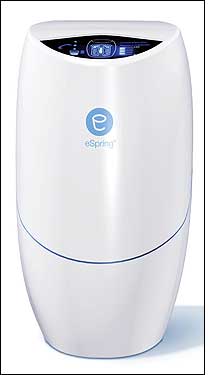Apr 01, 2009Nearly a decade ago, Fulton Innovation, a technology company located in Ada, Mich., and owned by Alticor, developed a patented water-purification system for Alticor's Amway division. Known as eSpring, the system employs a combination of ultraviolet (UV) light and a carbon filter to remove or destroy contaminants from tap water. But when Fulton decided to redesign eSpring in 2002, in order to improve its function, the company realized radio frequency identification could play an important role in the device.
Integral to the redesign was the introduction of a wireless powering system enabling the ultraviolet lamp within the purification system to be completely protected from the water inside the filter, thereby extending the product's lifespan by removing the external wired connection that had powered the lamp in the original design, and that could be subject to corrosion over time. The proprietary wireless power system—what Fulton dubs ecoupled technology—is based on magnetic induction, whereby a set of coils transmit and receive power through a resonant magnetic field. (Ecoupled and other induction-based wireless power systems are now beginning to hit the consumer market in charging stations for handheld devices, such as cell phones and digital music players.)
Wireless power makes the UV lamp easy and safe to remove from the purification system and replace, since the lamp is completely airtight and requires no external electrical connections. However, Fulton also needed to design a means by which the purifier's main control unit could track the lamp's usage, and communicate this information to users so they would know to replace the lamp when it neared the end of its expected lifespan. For the same reason, usage of the carbon filter element also needed to be tracked. In the redesigned eSpring purification system, RFID is utilized for both tasks.
"The performance of the carbon filter and UV lamp begin to degrade" after a specific usage threshold, explains Dave Baarman, director of advanced technologies for Fulton Innovation. When that happens, he says, "contaminants can be allowed to leech through the system." Therefore, it is important to replace both parts in a timely manner.
Embedded in each carbon filter unit and UV lamp unit is a passive 125 kHz tag manufactured by Atmel. An Atmel RFID interrogator, built into the purification system's main control unit, reads and encodes the tags with usage data, pertaining to the amount of water moving through the filter, and how frequently the lamp is activated.
The tags play two main roles, Baarman explains: They allow the main control unit to identify the lamp and filter, and they also provide a means of associating the usage data with a specific filter and lamp, so that this data can be regularly updated and the control unit can alert the user when either the lamp or filter has reached the end of its safe operating life and should thus be replaced.
Because the lamps and filters are manufactured in different countries, and since the exact powering specifications can vary between nations, the tags attached to the lamp and filter contain operating instructions that are conveyed to the interrogator through the tag data. The reader then conveys these operating instructions to the main control unit.
When the system is in use, one sensor measures water flow, while another tracks the lamp's power cycles. The RFID reader periodically writes this data to the tags on the filter and lamp. Later, when the reader interrogates the tags, it transmits this information back to the main control unit. Once the lamp or filter has reached the end of its useful life, the main control unit emits an audible warning and a visual alert on a small LED display.
Alticor has sold more than 1.5 million eSpring units to date, in more than 36 countries worldwide. Demand for the water-purification system is especially strong in Asia, Baarman notes, where municipal water quality is less consistent than in the United States.


